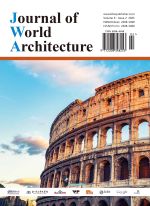The Relationship between Urban Memory and Typology: Utilizing Typology as a Design Tool to Preserve Urban Memory
Abstract
Urban memory is the soul and vitality of the city, which is created and maintained by people’s memory of the living environment. However, urban planning and architecture increasingly lose attention to urban memory, resulting in the loss of uniqueness of urban appearance, and then affect people’s sense of identity of the city. Therefore, using the theory of typology for reference, a new design tool - urban memory typology is proposed, which focuses on and introduces historical elements into urban design, and maintains urban memory through the protection of cultural heritage. This method involves clarifying the intrinsic relationship between existing buildings and urban space through typology theory, identifying carriers of urban memory, and, on this basis, proposing strategies and technologies for urban renewal. This study verifies the validity of urban memory typology through case analysis, such as the conservation planning of Qingdao Old city. The results show that using the typology theory can protect the city memory, maintain the stability of the city form, and enhance the local identity of the residents, which is a new method of urban planning and design in line with the concept of humanistic care and sustainable development. This research work provides new theoretical guidance and practical strategies for the protection of urban memory and urban planning and design.
References
Zhang W, Su Y, 2024, Perception Study of Urban Green Spaces in Singapore Urban Parks: Spatio-Temporal Evaluation and the Relationship with Land Cover. Urban Forestry & Urban Greening, 99: 13. DOI:10.1016/j.ufug.2024.128455.
Kim H, 2024, The Relationship Between Green Infrastructure and Air Pollution, History, Development, and Evolution: A Bibliometric Review. Sustainability, 16(16): 6765. DOI:10.3390/su16166765.
Huseyin G, Kaya M, 2024, Urban Heat Island Phenomenon in Istanbul: A Comprehensive Analysis of Land Use/Land Cover and Local Climate Zone Effect. Indoor and Built Environment, 33(8): 1447–1470. DOI:10.1177/1420326X241244724.
Viviane D, Bacelar D, 2024, Urban Tourists’ Receptivity to Ecogamification: A Technology, Environment, and Entertainment-Based Typology. European Journal of Tourism Research, (37): 1–35. DOI:10.54055/ejtr.v37i.3300.
Jiao L, Zhang M, Zhen F, et al., 2025, Alternative Lens to Understand the Relationships Between Neighborhood Environment and Well-Being with Capability Approach and Explainable Artificial Intelligence. Chinese Geographical Science, 35: 1–20. DOI:10.1007/s11769-025-1503-8.
Campbell N, Holden R, Gao S, et al., 2024, Deprescribing Anticholinergics to Preserve Brain Health: Reducing the Risk of Dementia Through Deprescribing (R2D2): Study Protocol for a Randomized Clinical Trial. Trials, 25(1): 1–12. DOI:10.1186/s13063-024-08618-4.
Vicua M, Baeriswyl S, De Dios B, 2024, Anatomias de la Verticalizacion en el Area Metropolitana de Concepcion. Revista INVI, 39(112): 146–179. DOI:10.5354/0718-8358.2024.74327.
Mildner T, Inkoom A, Malaka R, et al., 2024, Hell is Paved with Good Intentions: The Intricate Relationship Between Cognitive Biases and Dark Patterns: 1–15.
Norcliffe E, Majid A, 2024, Word Formation Patterns in the Perception Domain: A Typological Study of Cross-Modal Semantic Associations. Linguistic Typology, 28(3): 419–459.
Ling Z, Zheng X, Chen Y, et al., 2024, The Nonlinear Relationship and Synergistic Effects Between Built Environment and Urban Vitality at the Neighborhood Scale: A Case Study of Guangzhou’s Central Urban Area. Remote Sensing, 16(15): 2826. DOI:10.3390/rs16152826.
Delgado-Capel M, Egea-Carianos P, Carianos P, 2024, Assessing the Relationship Between Land Surface Temperature and Composition Elements of Urban Green Spaces During Heat Waves Episodes in Mediterranean Cities. Forests, 15(3): 21. DOI:10.3390/f15030463.
Xie S, 2021, From Historical Center to Historical City: Typology and Morphology-Led Contemporary Urban Planning Practice in Italy. Architects, 2021(02): 65–71.
Chen B, Yao G, 2021, Typology of Urban Water Transport Spatial Transformation. Urban Architecture, 18(30): 44–46.
Zhao Y, 2022, Typological Interpretation of Online Celebrity Space Under Digital Media. Urban Architecture, 19(18): 75–77.
Bofantini G B, 2019, The Evolution and Implications of Typology and Morphology-Led Urban Planning Techniques in Italy. New Architecture, 2019(01): 143–147.
Wu F, 2022, An Overview of Regional Typology. Historical Linguistics Research, 2022(02): 1–23.

